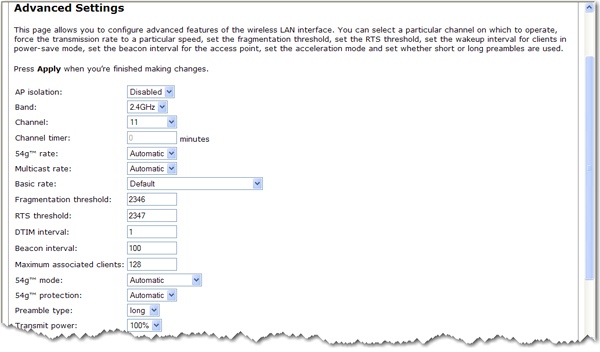
The fields in this area are for more advanced wireless features that most people do not need to change. If you do want to change any of these settings, write down the default settings before you make any changes in case you experience any problems and need to change these settings back.

AP isolation: Enable this item if you do not want your wireless devices to be able to communicate with each other.
Band: This is the range of frequencies the router will use to communicate with your wireless devices.
Channel: Sets the channel on which the router operates. If you are experiencing interference or wireless network problems, changing the channel may solve the issue. It is recommended that you keep the control channel set at "Automatic" to avoid interference with adjacent networks.
Channel timer: Set the time, in minutes, that the router should search for the best wireless channel. This option is only available if you channel selection is set to Automatic.
54g™ rate: You can select Automatic, 1, 2, 5.5, 6, 9, 11, 12, 18, 24, 36, 48, 54.
Multicast rate: Specify the rate at which multicast packets are transmitted and received on your wireless network. Multicast packets are used to send a single message to a set of recipients in a defined group. Teleconferencing, videoconferencing and group email are some examples of multicast applications. Specifying a high multicast rate may improve performance of multicast features. The rates are in Mbps. You can select Automatic, 1, 2, 5.5, 6, 9, 11, 12, 18, 24, 36, 48, 54.
Basic rate: Select the basic rate that wireless clients must support, either Default, All, or select a rate from the drop-down menu.
Fragmentation threshold: The maximum level the router will reach when sending information in packets before the packets are broken up in fragments. Typically, if you are experiencing problems sending information, it is because there is other traffic on the network and the data being transmitted is colliding. This might be corrected by the information being broken into fragments. The lower the level that the Fragmentation threshold is set to, the smaller a packet has to be before it is broken into fragments. If the maximum is set (2346), fragmentation is essentially disabled. You should only change this level if you are an advanced user.
RTS threshold: The RTS Threshold is the minimum size in bytes for which the Request to Send/Clear to Send (RTS/CTS) channel contention mechanism is used. In a network with significant radio interference or large number of wireless devices on the same channel, reducing the RTS Threshold might help in reducing frame loss. The RTS threshold is 2347 bytes by default, which is the maximum value.
DTIM Interval: This parameter configures the amount of time after which buffered broadcast and multicast frames will be delivered to the wireless clients. This allows mobile stations to conserve power. If you are using applications which use broadcast or multicast frames for delivering data, you should use a Delivery Traffic Indication Message (DTIM) Interval of 1 to minimize delay for real-time traffic, such as multicast audio and video streams.
Beacon Interval: The amount of time between beacon transmissions. A beacon is basically a heartbeat for a wireless client or router, sending out a signal informing wireless clients that the wireless network is still active. This should be set between 1 and 1000 milliseconds. The default beacon interval is 100 ms.
Maximum associated clients: Specify a maximum number of wireless clients for your router.
54g™ mode: Set this rate to Automatic for the widest compatibility, or to 54g Performance for the fastest performance with 54g-certified equipment. Select 802.11b Only if all your wireless clients support 802.11b mode only. 54g LRS (Limited Rate Support) is intended to support "legacy" (802.11b) clients that can't deal with access points which advertise supported rates in their beacon frames other than the original 802.11's 1 and 2 Mbps rates. Use 54g LRS only if you can't get a connection with the other three modes.
54g™ protection: If you set this option as Automatic, the router will use RTS/CTS to improve the 802.11g performance in 802.11 mixed environments. If this is set as Disabled, the 802.11g performance will be maximized under most conditions while the other 802.11 modes (802.11b, etc.) will be secondary.
Preamble type: Defines the length of the Cyclic Redundancy Check (CRC) block for communication between the router and wireless clients. The preamble consists of the Synchronization and Start Frame Delimiter (SFD) fields. The sync field is used to indicate the delivery of a frame to wireless stations, to measure frequency of the radio signal, to perform corrections if needed. The SFD at the end of the Preamble is used to mark the start of the frame.
If you are not using any 802.11b devices in your network, you can configure the Preamble type to Short for optimum performance. The Long Preamble type should be used when both 802.11g and 802.11b devices exist on your network.
Transmit power: Select either 20%, 40%, 60%, 80%, or 100% from the drop-down menu. The Power level sets the strength of the wireless signal that the router transmits. You would want a lower setting if you live in an area where your wireless signal could be overlapping with other wireless networks and want to reduce the interference you encounter.
Note: Click Apply to save all your new settings.